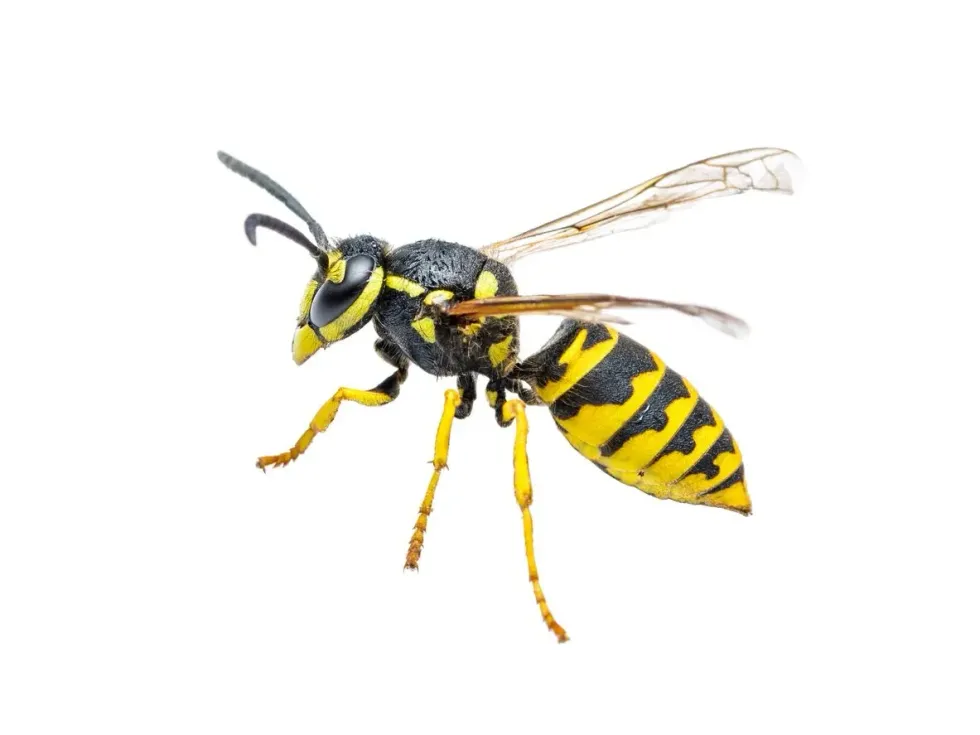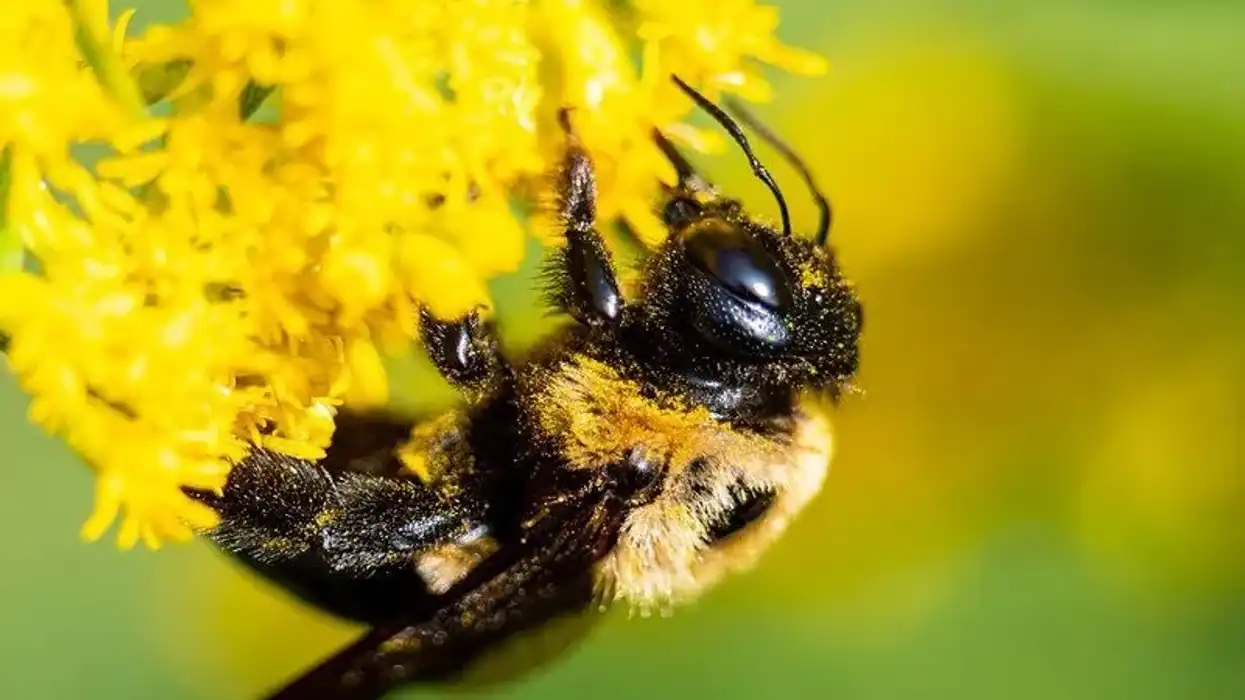Yellow jacket wasps, with the scientific name Vespula or Dolichovespula, belong to the Insecta class. Yellow jackets are pretty menacing insects that can be quite dangerous at times. These wasps are found near places where humans live and reside in hidden places, such as between walls and in hollow logs, within their nest colonies.
The yellow jacket queen wasps lay eggs in spring when she completes building her nest, and then the queen takes care of the eggs while the other yellow jacket wasp workers guard the nest against any dangers.
Here are some interesting facts on yellow jackets that you might enjoy. If you like these facts then do read our guides to the paper wasp and mud dauber wasp too!
Yellow Jacket Wasp Interesting Facts
What type of animal is a yellow jacket wasp?
A yellow jacket wasp (Vespula) is a social wasp insect that lives in colonies. Each of these insects has a sting that is powerful enough to kill a human!
What class of animal does a yellow jacket wasp belong to?
The yellow jacket wasp belongs to the Insecta class.
How many yellow jacket wasps are there in the world?
There are 16 species of yellow jackets that are found in North America. The most common species of yellow jackets are Vespula pensylvanica (western yellow jackets), Vespula maculifrons (eastern yellow jackets), and Dolichovespula arenaria (the aerial yellow jacket).
Where does a yellow jacket wasp live?
A yellow jacket wasp can be found anywhere that humans live but they are often found in meadows, orchards, woodlands, cemeteries, and urban and suburban settings where they build their nests. They build a paper-like nest just like hornets do made from wood fibers that have already been chewed underground or in hollow logs and other hidden places.
What is a yellow jacket wasp's habitat?
Yellow jacket wasps (Vespula) are found worldwide. They live near humans and build nests that are paper-like, hidden behind walls or hanging from trees where the nest is hidden and safe.
They live in groups in one nest where the yellow jacket wasp queen lays eggs and the rest of the wasps guard the nest to keep them safe from any dangers. Vespula maculifrons (eastern yellow jackets) tend to build nests closer to humans.
Who do yellow jacket wasps live with?
Yellow jacket wasps live in large groups, which are known as colonies. In one nest, there can live thousands of yellow wasps workers and queens together in colonies.
How long does a yellow jacket wasp live?
A yellow jacket wasp's lifespan depends upon many factors. Worker wasps tend to live for 12 to 22 days as the male yellow jacket wasp dies shortly after mating, while the queen wasp lives for one year in order to build a nest and take care of their eggs.
How do they reproduce?
In the spring season, a fertilized female queen begins to build a nest, where she will lay her eggs. She then looks after her eggs in the nest, which hatch into larvae, by grooming and feeding them while the other worker wasps guard the nest for their safety.
The larvae undergo a number of different stages to finally transform into a 0.63 in (15.9 mm) adult yellow jacket wasp.
What is their conservation status?
Yellow jacket wasps have the status of Least Concern and they are not endangered. Despite this, they struggle to survive cold winter weather or pests, which is why the fertilized female queen hibernates in her hidden nest, so that the nest does not freeze due to cold weather.
They are known for making nests closer to humans during winter, and usually, they live in groups, just like hornets and bees, making nests close to each other in order to support each other.
Yellow Jacket Wasp Fun Facts
What do yellow jacket wasps look like?
The yellow jacket wasp species, including Vespula maculifrons (eastern yellow jackets), look similar to normal wasps. They have black bodies with yellow and white striped markings. They are small in size, growing up to 0.63 in (15.9 mm). Like paper wasps and aerial hornets, they are social insects who build their nests out of reconstituted wood pulp like bees.
How cute are they?
Unlike bees, which is a species loved by many humans, the yellow jacket wasp is not particularly cute and can actually be quite dangerous. They are seen as a pest and are not considered to be cute.
How do they communicate?
Yellow jackets are social insects like hornets who communicate with each other through a complex use of chemicals that are known as pheromones. They produce different hormones in their bodies and use these to signal to each other about where food can be found or to alert the colony to the presence of an intruder.
How big is a yellow jacket wasp?
Yellow jacket wasps range in length from 0.5–0.625 in (12.7–15.9 mm) and are 10 times smaller than a mouse. These little yellow and black patterned yellow jackets are tiny!
How fast can a yellow jacket wasp fly?
A yellow jacket can fly up to 30 mph (48 kmph) and a human cannot outrun a yellow jacket. In fact, yellowjackets can become aggressive when around humans.
If a human scares a yellow jacket the pest can get so aggressive that it may sting between four and five times. A yellow jacket wasp sting is so we should be extremely careful if we care around these insects to avoid the risk of their sting, and shouldn't disturb their nests.
How much does a yellow jacket wasp weigh?
A yellow jacket wasp weigh around 0.0014 oz (0.04 g).
What are the male and female names of the species?
There are no different names for male and female yellowjackets.
What would you call a baby yellow jacket wasp?
A baby yellow jacket wasp undergoes three different stages before the time it becomes an adult yellow jacket wasp. The transformation from an egg into larvae, and then into pupae, before finally transforming into an adult yellow jacket wasp describes each life stage of a yellow jacket wasp.
As such, you can see that a baby yellow jacket wasp can be called larvae or pupae when young.
What do they eat?
This species usually eats other small flying insects and pests, like black hornets. Adult yellowjackets are attracted to sugary substances such as fruit, flower nectar, and occasionally soda if they find an open can of soda! They also eat insects like grubs, caterpillars, and worms. They are known to store food in winter in their nests, just like hornets.
Are they dangerous?
Yellow jackets are very dangerous as they get aggressive at times. They attack in groups like hornets, and their stings are more dangerous than the stings of bees because a yellow jacket can repeatedly sting its victim, whereas a bee can only sting once.
Anyone can have an allergic reaction after a yellow jacket stings them, and the sting can cause breathing problems which can at times be deadly.
Would they make a good pet?
Yellow jackets cannot be a pet because they become aggressive easily and attack humans. They are not friendly in nature and are menacing insects. They are advised not to be kept as pets, and if we see yellowjacket nests around us we should arrange to have them destroyed by a professional.
Did you know...
Many other insects mimic yellow jackets by using the same colors and patterns to scare off these pest predators.
Sometimes yellow jacket wasps, bees, hornets, and paper nest wasps live together in a common yellow jacket wasp nest.
If a yellow jacket stings a human 1500 times, then a human can die from the venom's toxic effects alone. Luckily, the likelihood of this is relatively low!
The purpose of a yellow jacket wasp is that its young feed on other insects, thus maintaining the balance of insects in a habitat.
What is the difference between a yellow jacket and a wasp?
A yellowjacket is more aggressive than normal wasps, hornets, or bees. A yellow jacket can bite and can sting numerous times but a wasp cannot. One interesting yellow jacket vs wasp fact tells us that a wasp is less poisonous than a yellowjacket.
How to get rid of yellow jackets?
If there is a nest of a yellowjacket inside your yard, you can hire a professional to get rid of the nest. They will use a gas that is formed by pyrethrum aerosols and that kills yellow jackets on contact.
These insects are attracted to sweet smells so to deter yellowjacket wasps you should eliminate any sweet smells in your yard and try not to leave open garbage near your house. Never try to kill a yellow jacket wasp yourself.
Here at Kidadl, we have carefully created lots of interesting family-friendly animal facts for everyone to discover! Learn more about some other arthropods including the water beetle, or Atlas beetle.
You can even occupy yourself at home by drawing one on our Yellow jacket wasp coloring pages.









